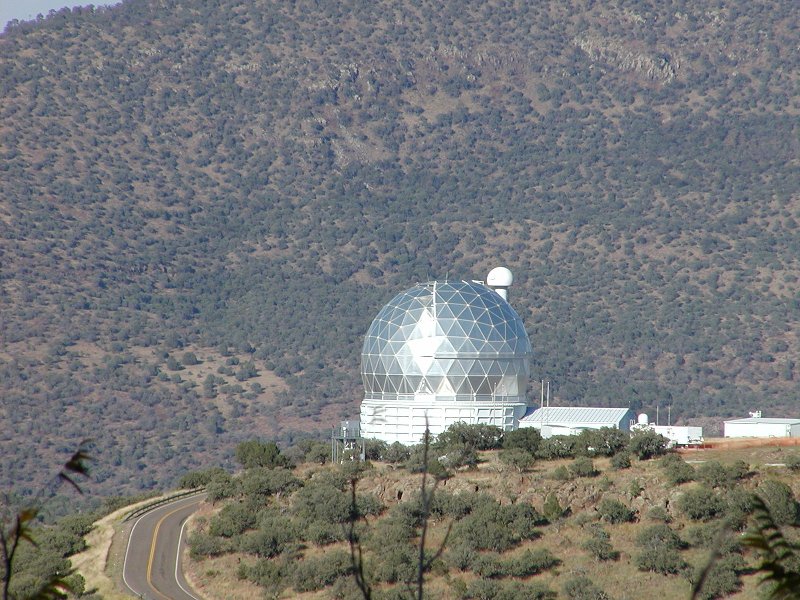Belated update: No publisher has expressed interest in publishing my book, so for all practical purposes Back Roads, Dark Skies is a dead project. If you want to know more, see the following:
Now if you want to see what might have been, read on….
The study of the Universe is a compelling story, one that combines the largest, the smallest, and the human into one vast narrative. In his classic travel narrative Blue Highways, William Least Heat Moon wrote, “New ways of seeing can disclose new things: the radio telescope revealed quasars and pulsars, and the scanning electron microscope showed the whiskers of a dust mite. But turn the question around: Do new things make for new ways of seeing?” It’s certainly true in cosmology: the process of discovery and exploration demands finding new ways of seeing. Our unaided eyes can only perceive a tiny portion of the electromagnetic spectrum, and are extremely limited what can be seen without the aid of technology. In modern science, “seeing” includes things far beyond visible light: not only other portions of the electromagnetic spectrum, but also lightless experiments such as tracking particles from collisions or from deep space. Even colloquially, “seeing” doesn’t necessarily imply vision only—it also covers comprehension.
Back Roads, Dark Skies itself is a travelog, but one that combines a physical journey with the metaphorical journey of scientific discovery. The physical journey is a road trip, in which I drive across the United States (and along the back roads of the title) in search of the labs and observatories where modern cosmology is done. Quite apart from the stereotype of the lone genius working in isolation to solve the mysteries of the cosmos, much of real science is done in collaboration, and requires a lot of technology. The metaphorical journey is concerned with the interplay between new ways of seeing and new things to see: how new technology has spurred discovery, but also how the drive to understand new phenomena has led to new telescopes and detectors.
Despite the vast scales of galaxies and the tiny scales of particle physics, cosmology is a human-scaled venture. By visiting observatories and labs, I hope to bring the science and practice of research together for readers, along with my own adventures across the country.
To research the book, I visited these facilities:
- Fermilab in Batavia, Illinois is site of the Tevatron proton-antiproton collider, and lab where the Dark Energy Camera (DECam) was assembled.
- Soudan Underground Laboratory in Soudan, Minnesota is a lab half a mile underground that is home to the MINOS (Main Injector Neutrino Oscillation Search) and Cryogenic Dark Matter Search (CDMS) experiments.
- Laser Interferometer Gravitational-wave Observatory (LIGO) in Livingston, Louisiana seeks to detect disturbances in spacetime itself due to supernovas and other violent phenomena.
- The Hobby-Eberly Telescope (HET) at McDonald Observatory in Texas is an 11-meter telescope made of many hexagonal segments. In the near future, it will be performing a huge survey of galaxies out to the edge of seeing, in hopes of measuring the properties of dark energy.
- The 2.5-meter Sloan Digital Sky Survey (SDSS) telescope at Apache Point, New Mexico is the most important telescope most people have never heard of, amassing a catalog of 500 million galaxies and other objects.
- The Very Energetic Radiation Imaging Telescope Array System (VERITAS) near Amado, Arizona detects the highest energy cosmic rays as they create showers of light when they enter Earth’s atmosphere.
- The Large Binocular Telescope (LBT) sits at the top of Mount Graham in Arizona. As the name suggests, it consists of two telescopes operating in tandem, providing a variety of detailed observations—including the hunt for exoplanets, planets orbiting other stars.
- The Jansky Very Large Array (VLA) near Socorro, New Mexico is a set of 27 large radio telescopes that work together to provide extremely high-resolution observations of the Universe.
If you are interested in reading a small preview of Back Roads, Dark Skies, the posts “In Search of Grote Reber” and “Ships on a Quantum Sea” provide a taste of what the book will be like. I hope you’ll stick around, and I’ll keep you up to date on the progress of the book (and hopefully news of its publication!).


Leave a reply to Some brief notes | Galileo's Pendulum Cancel reply